Graflex/Ciro Ciro 35The Ciro 35 is a fixed lens, leaf shutter rangefinder made by Graflex in the 1950's. This camera began as the Cee-ay 35 manufacutred by Camera Corp. of America. The camera design and tools were bought by the Ciro Camera company and renamed the Ciro 35 around 1949. Ciro produced three variations of the camera, a f/4.5 lens, f/3.5 lens and f/2.8 lens. The camera body was produced in gray and black. When Graflex bought the Ciro company, it continued to manufacture the Ciro 35 while also modifying the design to produce the Graphic 35. Some of the body parts are interchangable between the Ciro 35 and Graphic 35. I used a film rewind spindle from a junk Ciro 35 to repair a Graphic 35.The Ciro 35 is usually found with an Alphax shutter. (The Century shutter is simply the Graflex brand name for the same shutter.) Refer to the article on the Alphax shutter for disassembly and cleaning. This camera was also produced with the Rapax shutter. The lenses on these cameras are of the typical triplet design that was common on 35mm cameras of the 1940s and 1950s. When cleaned and properly adjusted, they should produce good quality pictures. To get the sharpest results you want to shoot stopped down to f/8 or smaller aperture. The rangefinder is of the split-image variety and is similar to the rangefinder on other American made cameras of this era. To focus, you look through the small window at the left side and adjust the focus until the top and bottom halves of the image match. Then, switch to the center window to frame the picture. To load the camera with film, turn the latch on the bottom to the open position and then slide the back down. After inserting the film slide the back in place and move the latch back to the close position. To advance the film, you press the button on the top and begin turning the wind knob. Release the button and continue turning the knob until it stops. After winding past the leader (2-3 frames), you can set the film counter by pressing down and turning the film counter dial to the first notch past the zero mark. To rewind the film, lift the Wind knob and turn it slightly so that it stays up. Turn the Rewind knob to retract the film into the cartridge. The top camera is one of the ones made after Graflex bought the Ciro company. It apperas to be a mixture of the gray top and back, but has the black shutter base. The shutter is labeled "Century" which is the Graflex name brand for the Alphax shutter. The shutter speed dial is normally the same gray color as the body. On this camera the paint had chipped off in many places and the brass had become tarnished. I polished off the remaining paint with the intent of repainting it. However, I like the brass look and decided to leave it alone for now. I may repaint it later or possibly get one from another camera. The middle camera is the all-black version manufactured by Ciro. You can tell the difference by the manufacturer's name stamped on the back and also because the shutter is labeled Alphax instead of Century. The bottom camera is the higher specification model with Rapax Shutter and f/2.8 lens. To open the back for film loading, turn the lever on the bottom of the camera to the "Open" position. Press down on the back and slide it down towards the bottom of the camera and it will then lift off. Do the opposite when putting the back on. After loading the film and winding to the start position, press down on the film counter dial and turn it to the first position. To advance the film, press down on the button located next to the film counter dial and start turning the winder knob. Release the button before you reach the next frame. To rewind, lift up on the wind knob and turn it slightly so that it remains in the up position. This will allow the takeup spool to rotate backwards. The camera shown in the disassembly pictures had a great deal of oil in the shutter causing it to be completely stuck. In addition, the grease in the focus movement had dried. I decided to disassemble both the shutter and focus. This requires removing the shutter and focus assembly from the camera. This is a very easy camera to work on and would make a good first project for someone just starting out tinkering on cameras. |
 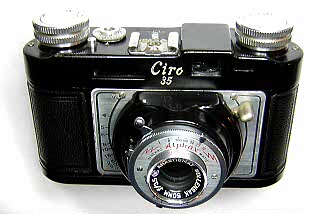 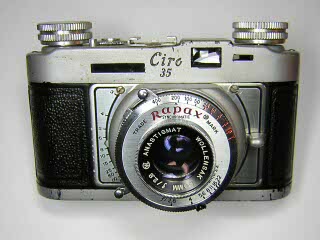
|
 |
Start by removing the back, holding the rewind shaft in place and unscrew the rewind knob. Take off the knob and spring then remove the shaft from inside. Remove the screw near the left end of the top cover. Note: Be careful when reinstalling the rewind knob. The rewind shaft is fairly soft alumninum and can be broken if overtightened. |
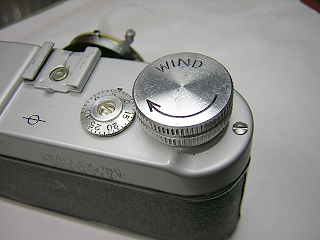 |
Remove the the screw in the film counter, then lift off the film counter, spring washer and spacer. Remove the screw from the right end of the top. The top cover will now lift off. Watch for viewfinder glass pieces that may be loose. On this camera, all the glue for the viewfinder glass and lenses had dried out and all of them fell out when I removed the top cover. If you are going to remove the front or shutter, Unsolder the flash wire. The wire is inserted into a slot in the end of the bracket. You will probably need to heat the solder from inside the bracket. |
 |
This image is a closeup of the fixed mirror for the rangefinder. The front screw is used to move the bracket back and forth to adjust the horizontal alignment. The aluminum bushing has an ecentric underneath that pushes a slot in the bracket. The rear screw is used to adjust the vertical alignment. Note: this picture is from the front of the camera. In the picture the bottom screw is the "front" screw respective to the camera. |
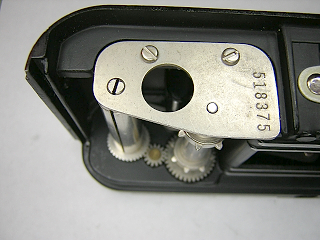 |
If you need to remove the film takeup spool or sprocket shaft, turn the camera over and loosen the two screws in the plate that holds the takeup spool and sprocket shaft. You can then remove these parts. For this repair, I left them in place. |
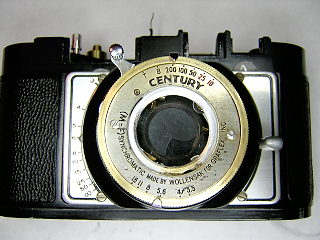 |
Unscrew and remove the front lens assembly. If the shutter is just running slow, you can remove the fascia and cover plate from the shutter and clean it in place. To remove the shutter from the camera, unscrew the four screws around the cover plate containing the focus scale and then lift the entire assembly off the camera. Pull the flash wire through the body. The wire goes into a hole underneath the top plate. The wire may be held in place with glue and you will need to soften and remove the glue. Turn the shutter assembly over and remove the rear lens element and the shutter jam nut. The shutter will then lift off the base. Watch for shims on the back of the shutter and be sure to replace them. Adding and removing these shims is the only way to adjust the focus. |
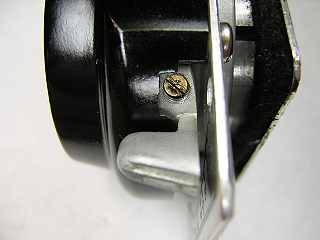 |
Move the focus lever to the infinity position. Remove the screw-in post. The lens tube will then pull out from the back. Note the slot in the lens tube. When reinstalling this tube, the screw-in post goes into this slot. There are no adjustments on this focusing mechanism, so there is no worry about disturbing the focus by doing this. |
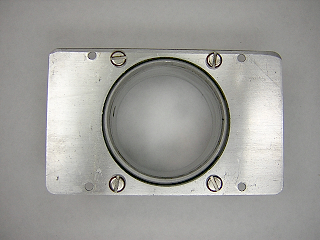 |
Remove the four screws on the back and lift the front plate off. |
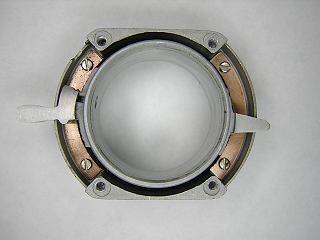 |
Remove the four screws holding the brass wings on the focus ring. The focusing ring will then lift out of the shutter base. The two wings and felt seal pull off from the focus ring. Clean and lubricate where the focus ring rubs against the shutter base and also where the brass wings rub against the focus ring. A silicone lube gel works well for this. If nothing else, you can use auto-chassis grease, but the oil in that type of grease tends to migrate out over time and may cause problems in the future. Other than shutter cleaning and RF adjustment, that's about all there is to do on this camera. |